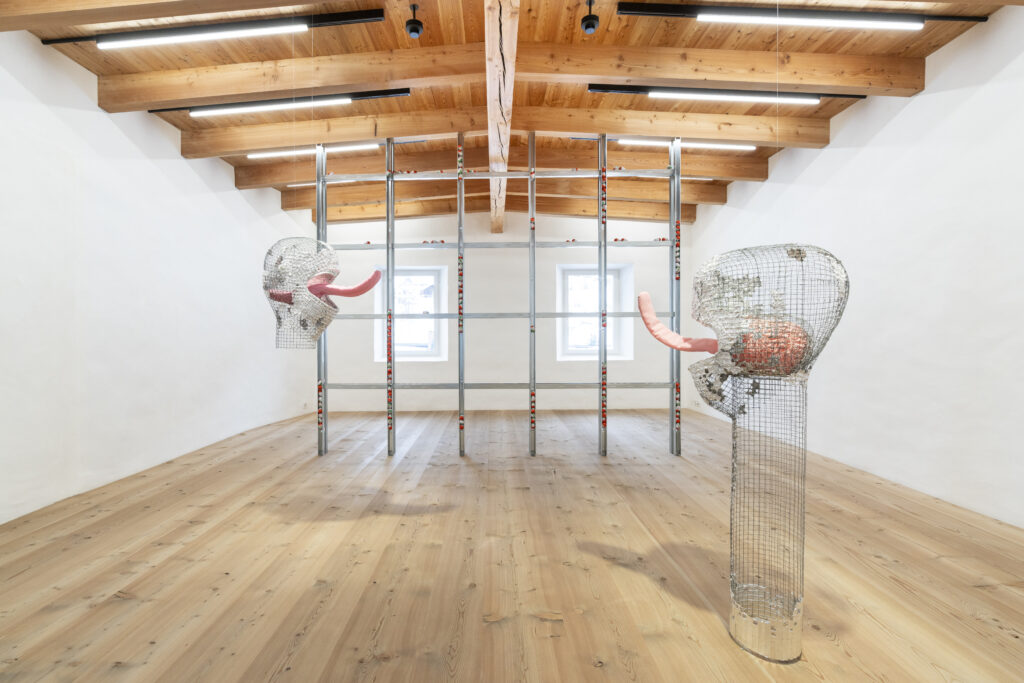
Anu Põder (1947–2013) was an Estonian sculptor and installation artist. Throughout her career, she experimented with new abstract forms and a variety of materials from plaster and wood, charcoal and textile, to light, scent and taste. Põder’s work was inspired by her own experience as well as her surroundings and environment in the city and in countryside, at home and at work. Põder’s pieces were time and site specific and created to be exhibited as such – the presence of the artwork relied on a performative effect, meaning the artworks disintegrate over time.
Põder’s work can be viewed in two chapters: the first, facing inward, looking at a young woman’s journey to motherhood and being a middle aged woman at the very end of the Soviet period; the second chapter sees the artist slowly turning her gaze outward and commenting on social processes in the newly independent Estonia. Põder’s early work did not fall in line with the principles of the so-called bronze age, when Estonian sculptors were casting an extraordinary number of monuments and portrait statues – she did not work with bronze, but followed the formal experimentation direction prevalent at the time, guiding her from Surrealism to depictions of pop culture and everyday life.
Already during her studies, Põder began depicting people as dolls, created by using wire structures, plaster, cotton and textile. In the second half of the 1980s she added plastic to her selection of materials – one of the earliest examples of that decade by Põder is “Big doll which was made to sit” (1982). Additionally, in the 1980s Põder created a number of abstract sculptures made of burlap, plastic, paint, tar, textile filling and metal, such as “Composition with a net”, “Composition with strings”, “Composition with red gloves” (all 1983) and “Very old memories” (1985). The sharp tips in these compositions seem to symbolise a defensive position that protects what is held dear from the robustness of the outside. In the second half of the 1980s Põder began experimenting with pinkish plastic sheets, used in medicine at the time. These plastic sheets were sewn together to create compositions of female torsos, such as “On one foot from Lasnamäe” and “With a brass wind instrument from Lasnamäe” (1988) as well as her most know works “Figure which was made to walk” and “Man’s head with a flag” (both 1984).
In the 1990s Anu Põder completed her series of dolls, including works like “Rolled-up figure” (1992), “Coiled” (1993), “Composition with a hanging head” (1994) and “Light Stuffed Figure” (2001). Põder’s work went through a significant change with a series she began in 1995, “Pattern as sign” – she started cutting up garments, fur coats, coats and boots that were from times long passed. The works “Pattern as sign. Fur coats” (1996) ja “Clodhopper, stride of a man of the 20th century”(1999) is dedicated to the lives of men of the 20th century, whereas “Space for my body” and “Ancient light” (both 1995) seem to focus more on women.
A new and sensuous turn in Põder’s work was brought about by her use of soap: in 1998 she completed the soap-cast series “Tongues” and the year after that “Clodhopper”. In the following years Põder experimented with new plastics and human silhouettes until her 2007 exhibition “Super”. There, she exhibited the metal net and foil work “Lickers” (2007) that stretched its joyous pink tongues towards a table covered in fat, wall profiles filled with chocolate eggs and sweet-smelling honeycombs. The 2000s, when compared to the Soviet period and the first decade of independence in Estonia, saw an increase in opportunities, which contributed to the emergence of a new perspective on the relationship between the individual and the society in Põder’s work. Another of her works, “Lectern” (2007) plays with the viewer’s sense of smell – one side of the piece looks impeccable with a glass of water waiting for a lecturer, from the other side, however, we see that the lectern is charred. The work “Worn decoration” (2008) counterbalances obsession with beauty by making bits of charcoal and plastic pearls into a stunning necklace that simultaneously stains the wearer but also draws attention to itself.
Anu Põder studied at Tartu Art School between 1967 and 1970, as well as at the Estonian State Art Institute’s sculpture department from 1970 to 1976. Until 1986, Põder worked as a freelance artist and after that, shared her time between her artistic practice and her students at the Estonian State Art Institute and Tartu Art School. Põder has received the Kristjan Raud Art Award (2008), the Sculpture Quadrennial Riga Prize (2000), the Estonian Artists Association Award (1990), the Young Artist Award (1979) and the Teacher of the Year Award (1994). Põder’s works belong to the collections of the Art Museum of Estonia, Tartu Art Museum and to her family.